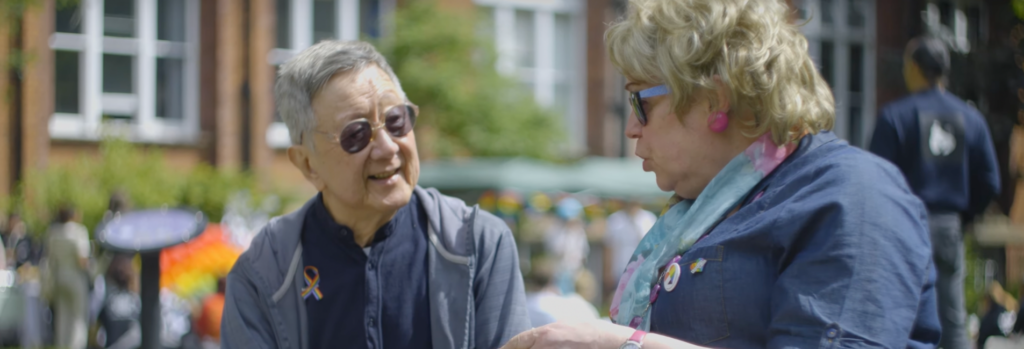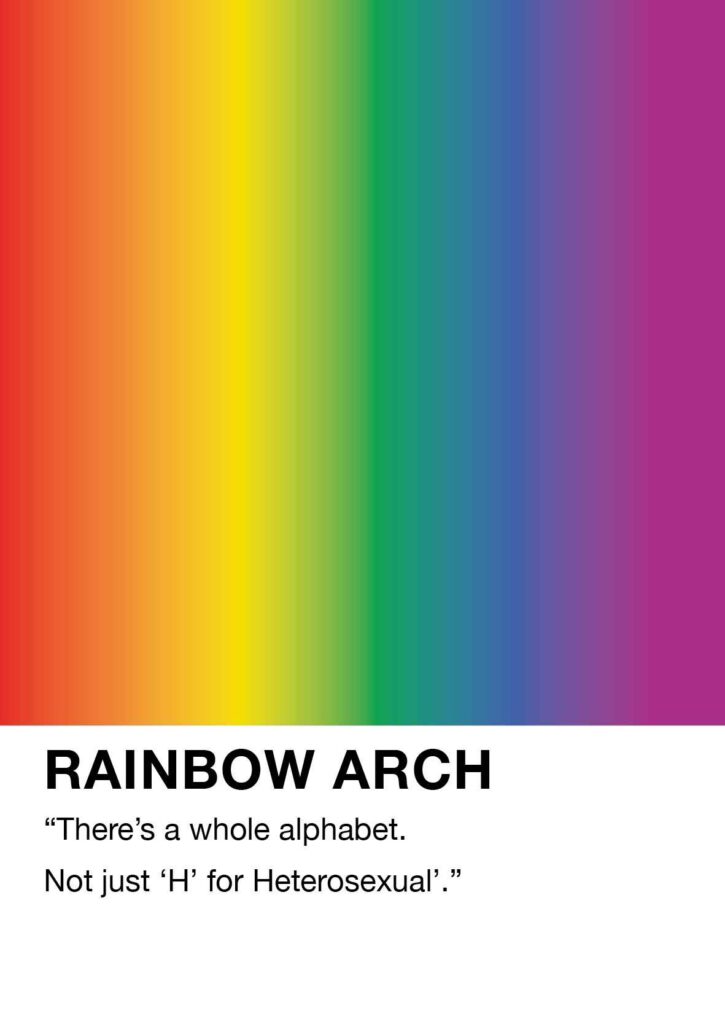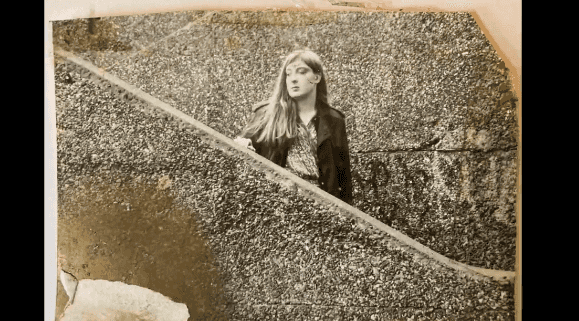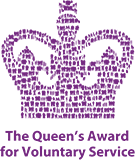
BACK IN THE CLOSET
A ground-breaking artist residency project shed light on LGBT people’s experiences of sheltered housing and independent living schemes

Image credit: Back in the Closet setup, image by Anna Raczynski.
Running from February 2020 to Summer 202, the Back in the Closet project saw four artists paired with older persons’ housing schemes across Greater Manchester to work with both staff and residents to open a discussion on LGBT identities and to find both small and significant changes to make these environments more inclusive.
I kicked the doors off that closet years ago…and they are not going back on for anyone” Bill Moss, Back in the Closet participant.
Each artist was paired with a housing scheme and collaborations took place remotely or socially distanced due to restrictions in place as a result of the coronavirus pandemic. Artists were open to working with staff and residents at each scheme, to co-create an artistic response to their experiences using photography, creative writing, film, installation or performance.
The artists and housing organisations who took part were Anna Raczynski with Great Places Housing Group, Lauren Sagar with Calico Homes, Tamzin Forster with Trafford Housing Trust and Jez Dolan with housing schemes represented as part of Rainbow Roofs. With special thanks to all of these housing associations and to One Manchester for their support.

Image credit: Colour swatch 10 by Tamzin Forster and Mary E Taylor.

Image credit: Still from Is That All There Is? Seasons of Life/Moments (Frozen) In Time by Jez Dolan and Paul Richards.
Back in the Closet was a partnership project between Greater Manchester Combined Authority, House Proud NW and Pride in Ageing at LGBT Foundation. A huge thank you to everyone who took part.
Please note: Permission for any further use of the Back in the Closet artworks must be sought from the Pride in Ageing programme via prideinageing@lgbt.foundation or for press media@lgbt.foundation.
Anna Raczynski
Biography: Anna is an artist filmmaker, working primarily within the field of community-based, documentary art practice. Over the last few years, Anna has worked on numerous commissions in Lancashire. Most recently, she created a series of video portraits for the Harris Museum in Preston, comprising a diverse range of people linked to the Preston Bus Station. Her film project The Movie Makers (2018), was made together with older members of an amateur filmmaking community group in Colne (East Lancashire).
https://annaraczynski.com/ANNA-RACZYNSKI
Partner Housing Scheme
Great Places Housing Group https://www.greatplaces.org.uk/
Jez Dolan
Biography: Jez is an artist based in Manchester / Salford, working from his studio at Paradise Works in Salford. He has exhibited and participated in a wide range of exhibitions and projects nationally and internationally. Jez’s work currently explores queerness and identity through the codification of language, with a specific focus on secrecy and hiddenness – the things we don’t say. Text and language act as both form and content in his work, which is interdisciplinary and research-driven, whilst often exploring archival source materials from which to create new artworks. Jez works with different media according to the needs and context of each project: from printmaking and drawing to performance, installation and curating.
Jez Dolan https://jezdolan.com/
Partner Housing Group
Rainbow Roofs https://twitter.com/roofsrainbow
Lauren Sagar
Central to Lauren’s artistic practice is an interest in narrative and personal history.
Partner Housing Scheme
Calico Homes https://calicohomes.org.uk/
Reflections on a participatory art residency during Covid lock down – Family and LGBTQ+ visibility
INTRODUCTION
For the first time in its 220 year history, the 2021 census asked us about our sexuality and gender identity;
Which of the following best describes your sexual orientation?
Straight or Heterosexual
Gay or Lesbian
Bisexual
Other sexual orientation
(Write in sexual orientation)
Is the gender you identify with the same as your sex registered at birth?
Yes
No
(Enter gender identity)
The data will give us a clearer picture of the numbers of LGBTQ+ people living in England and Wales.
If we do discover, as was generally assumed when I was coming out as a young woman in the 1980s, that at least one in ten of us is queer, then surely all families are queer families?
It must be time to shake up our collective public depiction of two (heterosexual) parents and two children, and create a picture that much more resembles our lived experience. By shining a bright and sparkly light on openly, and positively queer families, ‘normal’ will come to look very different.
It will be acceptable and comfortable to share about our nearest and dearest; those chosen, found, given birth to, remembered.
A COVID TIMELINE
Pre Covid
Here is the Back In The Closet brief that I responded to –
Greater Manchester Combined Authority, House Proud and the LGBT Foundation are working together to explore the lack of LGBT visibility in retirement schemes and care settings.
Many LGBTQ residents feel unable to disclose their sexual orientation or gender identity to staff and other residents and this project will look at reasons for this, the impact on residents, staff and visitors and the positive changes that could be made to increase diversity in these settings.
We are looking for 4 artists, makers or creative practitioners from any art form to deliver individual artist residencies in 4 retirement schemes and to work with both staff and residents to explore this topic.
Pre lock down
I proposed a project involving storytelling, the written word and performance, in relation to the chosen family. The residency would be a mix of one to one conversations, group workshops, and hands on creative sessions.
Each of us has a unique and valuable story to tell about our experience of family, and this project is inspired by individuals who have, often by necessity, chosen and created theirs. Choosing one’s own family is an act of strength and resilience, and sometimes even saves lives. It is fundamental for some of us, and an unexpected blessing for others.
Just before lock down
On the way to our first meeting altogether at Calico offices in Burnley, I’d been listening to the radio in the car and they reported that people in Italy had been advised not to shake hands. I met Hayley in a busy reception area and said, “I’ve decided not to shake hands with people for the time being.” At that point, it seemed to me, there was silence, and all heads turned! Since then we have only met online.
Lock down
The advantage of not being able to meet up physically has been that the project has taken on a dynamic collaborative approach. We are creating the way forward and shaping the project together; me, staff, participants who are also residents.
THE PROJECT
I’ve found this project deeply moving. Right from the beginning, when I read the brief for the residency, I felt so sad that, after a lifetime of coming out, negotiating life through a forest of prejudice and negativity, creating new ways of being with family, and having family, LGBT+ people often need to go back into our boxes and tow the line when moving into supported housing. Where there should be pride and celebration there is quiet.
There is so much to learn from those of us who have been at the forefront of social change in relation to sexuality, far too much for it to then become hidden during our latter years.
Here was my proposal for an art project –
One of the things that hides LGBT people in plain sight is that our families don’t always fit into what is seen as the norm according to the law, creating a further barrier to sharing about our lives and experience. What I’ve discovered is that choosing one’s family is far from unusual, and is not just part of the gay community reality. I see it as a strength and an experience that connects us. It symbolises love, care, solidarity and creativity in shaping one’s own life.
A while ago a good friend’s partner of five years died suddenly while they were on holiday.
He died intestate and had never spoken about his blood family, just about his family of friends that he had known for over 40 years. These were the people who were there for him and his partner throughout their relationship and after his death.
Once his next of kin, whom he had not seen for decades, had heard about his death they started to appear; the estate went to them automatically, and my friend had to move out of the flat where they lived together.
The experience reminded me of life as a lesbian where many of us in the gay community, having been rejected by our blood families, choose our own. Even at primary school, my son’s experience of having two mums was often silenced by activities that involved descriptions of family as mum, dad and children living together.
I’d like to explore the ‘un-family’ with residents and staff sharing their own experience, the exploration building and developing a shared narrative and celebrating the individual experiences. The form that the celebration takes will evolve from the individuals working together. It could be a one-off performance by the individuals themselves, or by actors speaking their words. It might be a series of drawings created by those involved. Maybe it will be a film or recorded interviews that are available to people after the residency.
When I read this now, I realise how ambitious it was considering the residency should have taken ten days to complete, typical artist optimism and enthusiasm!
So in some ways, Covid did me a favour. It slowed me right down. The fact that we had to work remotely pushed me to find ever more creative ways to work with people.
The most important opportunity presented by this enforced way of working was for us to work truly collaboratively; me, the staff and participating residents. We were all finding our way through the unknown, all of us committed to making some changes in the experience of LGBTQ+ people who live in Calico homes.
The process has been slow, steady and responsive, appreciating all of our particular challenges with the given situation; a mutually caring and supportive way of working.
It has taken time to gather pace, which on reflection, I think is positive; this way, it can build and become embedded. Rather than many people being involved a little bit.
We have been very fortunate that the project has further funding (from Calico and from In Certain Places in Preston) to continue the work.
The focus of the project currently is on two women in one family; a mother (I am calling her Mother here) and her lesbian daughter (Daughter), both brought up in Burnley. We are hoping soon, with the help of a professional writer, that Mother and Daughter will be turning their story into a piece of art. Whether it becomes a performance, a recording, or a piece of writing, will be determined as part of the collaborative process.
The wish is that it will inspire others to tell the story of their ‘queer family’, and that the project will build.
Daughter said, “Even if it helps one person that will be good.”
A FEW QUOTES FROM MOTHER AND DAUGHTER – a work in progress
“My daughter is gay and very happy. I don’t understand most of the jargon that is about today, I do believe family is whatever people want it to be. There must be tolerance towards any person living with us.
I don’t mean tolerance, I mean freedom to be.” (Mother)
“I don’t know why I was so nervous to tell my mum. I was brave and had had a few drinks. She just hugged me.” (Daughter)
“When my daughter told me she was gay I had no idea she was but apparently some of my family had known for a while. (my daughter) had rung me and said she needed to come and see me she was in tears. I thought she was going to tell me she was pregnant.
She came in and said “You might not love me anymore, when I tell you this, I’m gay” I put my arms around her and said if she was happy it was not a problem and I loved her.
A while later I asked her if her brother knew and she said yes. I asked what he had said, he had said, I have no problem with it but don’t pinch any of my girlfriends.” (Mother)
This is the story of an extended and large ‘family’, Aunties who aren’t related by blood, friends who are held as close relatives, ‘step-parents’ – let’s forget the ‘step’, these are mums and dads.
“We had a number of Aunts and Uncles not related to us. I took this as respectful. These were the people mum relied upon and vice-versa. Good friends “Aunty G….. and Uncle J…” lived on the street next to us, they had seven boys and we were six boys.
Most days mum would nip to Auntie G….. and tell her, I’m percolating. 10 minutes later they would be drinking coffee and nattering.
Uncle J…. was a “drinker”, many times going to theirs you could him shouting etc. When sober, on some weekends, he let us all know where to meet him for a walk.
We always took water (Corporation pop) and sandwiches. There would always be at least twelve of us different ages. We really did go up hill and down dale and it was fantastic. We had water fights, climb hills, climb trees. It was freedom but with friends who ended up “mates”. Sometimes someone would have an accident but thankfully nothing major; Joe would say ‘Youl be reet’ when someone did have an accident.
P.S. We swapped sandwiches, i.e. jam, salmon/beef paste, egg, spam etc.” (Mother)
Tamzin Forster
Biography: Tamzin is a Manchester based, freelance multi-disciplined visual artist and creative wellbeing specialist, with over 20 years experience.
Tamzin Forster https://www.tamzinforster.co.uk/
Partner Housing Scheme
Trafford Housing Trust https://www.traffordhousingtrust.co.uk/
With any project such as this I will try and put myself in someone’s shoes… Therefore this artwork speaks generally and personally, as of course I have been influenced my own perspective – my feelings, emotions and thoughts provoked during our discussions and throughout this project. Throughout the project I have considered how I might feel as a gay woman who could in theory move into a residential scheme within 13 years.
The piece of writing that you see on the right page of the photograph I wrote from the perspective of someone who shuns those that identify as LGBTQIA+.
The activity – that the piece of writing came from – was designed to emphasise the topics of identity, semantics, reclaiming and reframing language, the use of labels and being aware of assumptions and the heteronormative bias within our society, and the importance of self-identification. I discussed the term ‘Queer’ with Mary (the project participant), and they shared that ‘Queer’ was a slur in their day, whereas for me I would choose it as a label for myself today.
The creative writing technique uses ‘sculpted’ or ‘found’ writing. For the creative guides I chose two texts for people to potentially use and created examples. The other piece of writing is much more defiant, liberating, and proud; compared with the one that I actually chose to work with here. The one I use, on its own could be perceived as cynical…
The text I sculpted from is from the fictional novel ‘The Well of Loneliness’, which was banned in 1928 due to ‘obscenity.’ It references a lesbian relationship twice; and as I write in 2021 it’s uplifting to know that 93 years later there are now books which give a much more open description of same-sex love without fear of reprisal. I chose a page at random. The piece of writing sculpted from the original ‘found’ words reflects a dismissive, dis-compassionate view of a made-up characters who perhaps gossip ‘Are you sure?’ ‘Why should I care?’ To the homophobic view along the lines of ‘let her live-in discomfort and shame’… with the belief that ‘After all she has the plague.’ Regardless of whether these people exist or not in an individual’s community/home environment such as a residential scheme, this character can exist in someone’s fears, and be a barrier to ‘belonging’ – that sense of being fully accepted for who you are. This holding back can have a profound effect on a person.
I’ve always found the idea of a ‘closet’ a curious one. I understand it conveys a conflicting idea of ‘coming out’ to that of having ‘skeleton’s in the closet.’ I like it as a metaphor…imagining climbing in and out of the closet? So tedious. People who identify as LGBTQIA+ often find themselves making a daily choice to ‘come out or not’ when someone unknowingly makes the assumption that they are ‘straight’; or as an example amongst many, attempts to satisfy their curiosity and pushes for someone to ‘out themselves.’ I liken this more to being under an archway, something that (has potential) to loom over you and can cast a shadow. Under which your thoughts can lurk between ‘what are the consequences to me coming out?’ ‘Does it create a situation where I am pushed into a negative situation (‘darkness’) due to someone’s reaction; or will it relinquish that weight of uncertainty and allow me to step more fully into myself and bask in the sunshine?’ You may or may not notice the rainbow light falling from the right-hand corner to the archway (CD and torch and a necessity for a third arm!).
This rainbow also for me represents the hope that pervaded for me as I spoke to Mary as ‘an ally.’ That were I to move into a housing scheme I might have a supporter. And a hope that other people in residential schemes at this moment in time feel accepted by their allies. The butterflies also convey this hope – a symbol in art of endurance, evolution and therefore change, hope and life.
You might notice the use of colours and words on the butterflies; cut out of delightful paint swatches with the wonderful names that I created with Mary in our sessions. We chatted about the symbolic meaning of colours, and how they can also influence mood. Mary also created a wonderful mood board and a found poem on the theme of ‘comfort’ with them’, and we talked about how the word comfort comes from the Latin word ‘confortare’ – ‘to strengthen’. I believe hope and endurance builds strength. I used a warm coloured light to embody this.
The purple flower is a nod to the poet Sappho, and the adoption of the pansy/violet in the LGBTQIA+ community.
Mary and I spoke at length as to how fear, ignorance, and lack of exposure to ‘diversity’ can be the foundation of non-acceptance of someone else’s gender or sexual identity. We agreed that alongside compassion and empathy, education and open-mindedness was key to a wider acceptance of ‘different.’ The choice of the open book attempts to symbolise knowledge and an open-ness.






